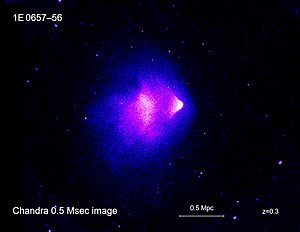Bullet cluster
The Bullet cluster (1E 0657-558) consists of two colliding clusters of galaxies. Strictly speaking, the name Bullet cluster refers to the smaller subcluster, moving away from the larger one. It is at a co-moving radial distance of 1.141 x 109 parsecs (3.7 billion light-years).[1]

Gravitational lensing studies of the Bullet cluster are claimed to provide the best evidence to date for the existence of dark matter.[2][3] However, this interpretation of the gravitational lensing results is disputed. Observations of other galaxy cluster collisions, such as MACS J0025.4-1222, are similarly claimed to support the existence of dark matter.
Mordehai Milgrom, the original proposer of MOND (Modified Newtonian Dynamics), has posted on-line a rebuttal of claims that the Bullet Cluster proves the existence of dark matter.[4] Milgrom claims that MOND correctly accounts for the dynamics of galaxies outside of galaxy clusters, and even in clusters such as the Bullet Cluster it removes the need for most dark matter, leaving only a factor of two which Milgrom expects to be simply unseen ordinary matter (non-luminous baryonic matter) rather than cold dark matter. Without MOND, or some similar theory, the matter discrepancy in galaxy clusters is a factor of 10, i.e. MOND reduces this discrepancy five-fold to a factor of 2.
References
change- ↑ "Your NED Search Results". ned.ipac.caltech.edu.
- ↑ "Archived copy". Archived from the original on 2013-06-25. Retrieved 2015-10-08.
{{cite web}}: CS1 maint: archived copy as title (link) - ↑ Markevitch M.; et al. (2004). "Direct constraints on the dark matter self-interaction cross-section from the merging galaxy cluster 1E0657-56". Astrophys.J. 606 (2): 819–824. arXiv:astro-ph/0309303. Bibcode:2004ApJ...606..819M. doi:10.1086/383178. S2CID 119334056.
- ↑ "The Bullet Cluster (Milgrom)". Archived from the original on 2016-07-21. Retrieved 2015-10-08.